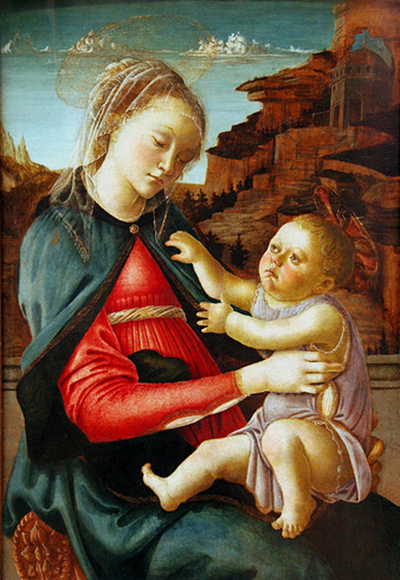Artist Botticelli continued his devotion to the religious theme of Virgin and Child within this painting which dates from circa 1470. It is now owned by the Louvre and displayed at their gallery in Lens, Northern France.
In this particular iteration, the Virgin and Child are placed directly in front of us, with everything else in the painting serving merely as a support. The Madonna wears simple but elegant clothing, with a red dress and blue coat over the top. Botticelli adds some details to her outfit, such as pleats and a chest belt, but generally keeps things modest and simple. She also has her hair covered with a transparent cloth which hangs down to her shoulders. The child is perched on her left leg, and looks slightly uncomfortable, with an expression suggesting he wants to move. The face is plump and it wears just a single item of clothing which is light purple in colour and covers most of the body. It is not as angelic in features as one might expect, and this is a look found in many of Botticelli's depictions of the Virgin and Child, which is also somewhat typical of that period.
Documentation from past centuries have helped uncovered the path of attribution that this painting has been through. At various points it was actually believed to have come from the hand of Verrocchio, or perhaps from within his circle. Filippo Lippi has also been mentioned. These names form some of the key members of the Early Renaissance, which perhaps underlines the technical qualities of this piece as much as anything else. In fact, all of these artists produced a large number of artworks on this theme, meaning similarities could be drawn with all of their careers by comparing this piece with others that they had contributed. That said, more recent historians have pretty much all chosen Botticelli as the most likely creator, and we today have many more avenues of research than would have been the case in previous centuries.
This painting is believed to have been bequeathed to the Louvre in 1914, just at the start of WWI. It is dated by some as being from the 1460s, though the most reliable experts put it at 1470. There are a wealth of Madonna and Child paintings by Botticelli during both of these decades and so it is pretty hard today to be any more precise than that. The artwork has since been moved to one of the Louvre's provincial galleries in Lens where it sits alongside a number of other famous artworks. This gallery enables more people to see some of the institution's incredible collection, as well as providing further display space on top of their huge museum in central Paris. Some of the items to look out for here include Venus with Apple by Bertel Thorvaldsen, Saint Matthew by Rembrandt, as well as a large amount of items from ancient civilisations which can help to attract a different audience.




